Learn how to save chili pepper seeds from your garden-grown peppers so you can store them and use them to grow peppers the next season.
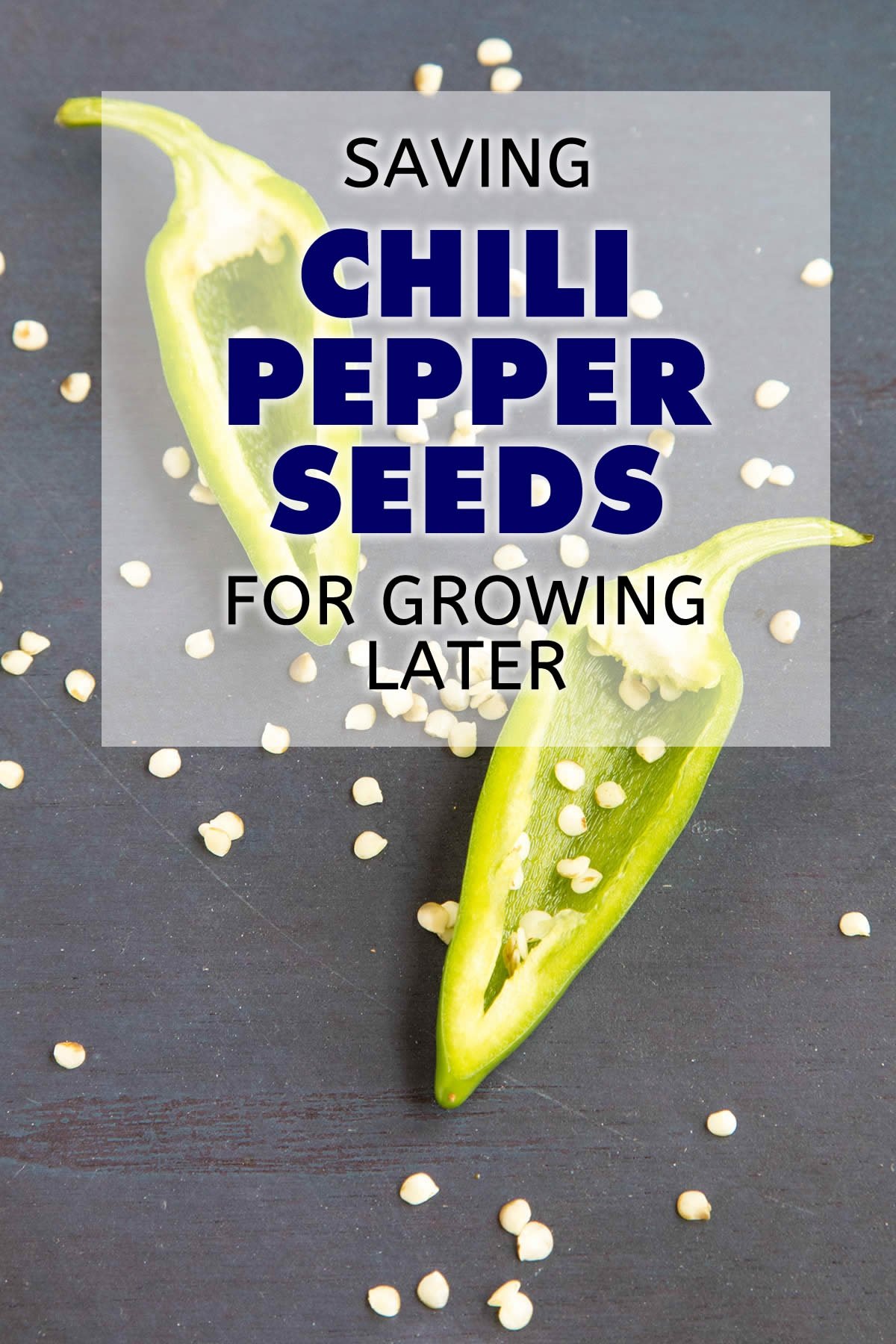
As a chili pepper grower, you may want to save the seeds from your current batch of chili peppers rather than purchase new seeds each year. Saving seeds also saves money, and ensures your harvest will include your very favorite peppers from season to season.
Luckily for us, chili peppers lend themselves to easy seed saving. Harvesting the seeds is a simple process, and they require very little effort to dry and store.
The only major issue to consider, however, is the possibility of cross pollination from other peppers in your garden.
Pepper plants can cross pollinate, so if you do grow multiple peppers in your garden, you’ll want to take steps to limit cross pollinating.
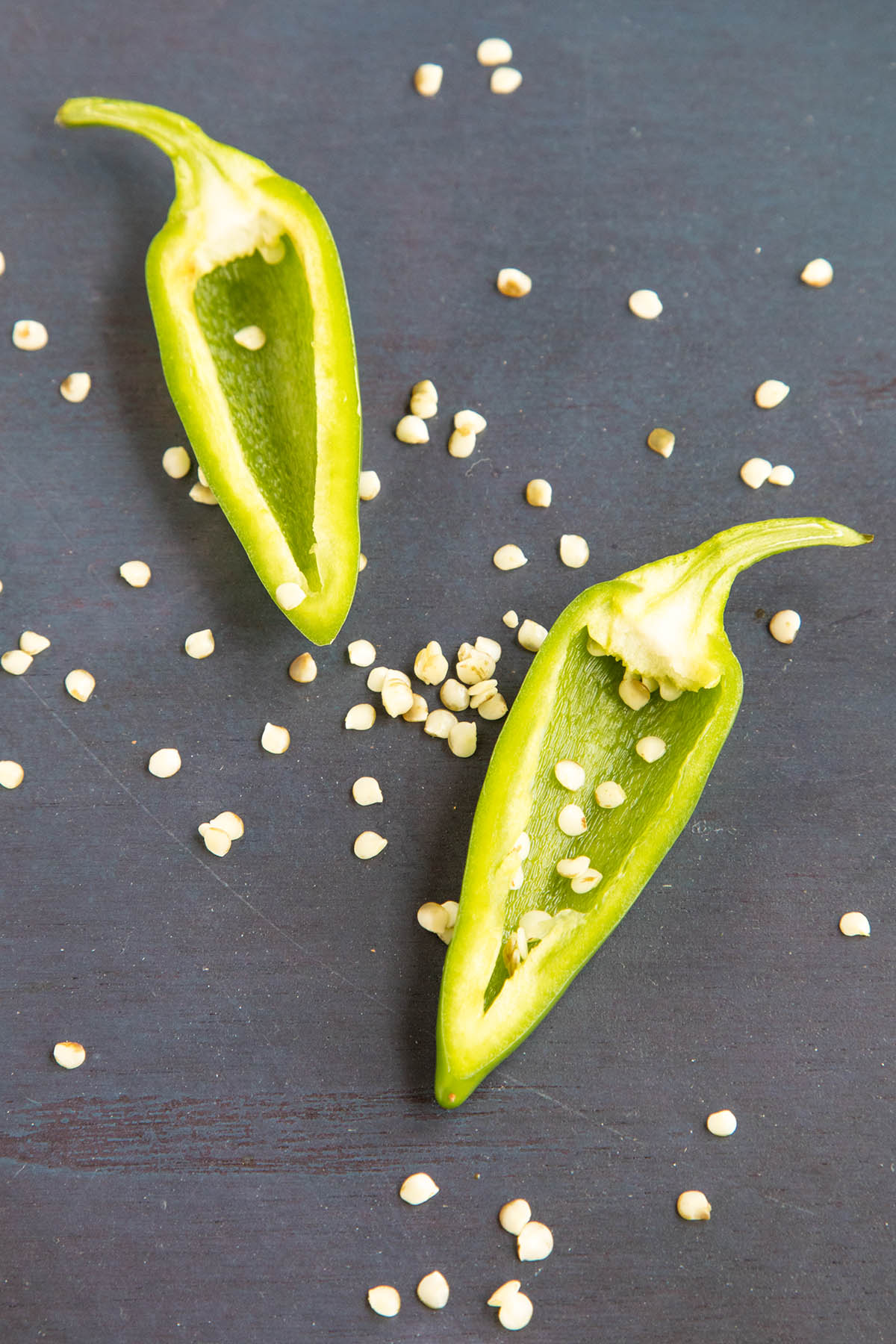
Cross Pollination
You may be familiar with the idea of cross pollination in the pepper world with hybrid peppers, like many of the superhot varieties. The concept generally means that genetic material from one type of pepper plant will exchange with another.
This genetic variant will not show up in your current plants, but may show up in future generations grown from those seeds.
This is a highly popular method for creating new pepper strains with new and interesting characteristics, such as thicker pepper walls or greater heat.
If you want the same peppers from year to year, it is best to not save seeds from cross pollinated pepper plants.
If you are growing plants for seed, then grow them at sufficient distance from one another, or better yet, use specialized netting to protect them.
Note that not all chili pepper species cross pollinate. Annuum will cross easily with Chinense, sometimes with Baccatum and Frutescens, but not with Pubenscens, which generally does not cross with any other species.
If your goal is to grow seed and sell them commercially, you will need to isolate your plants by type and take steps to ensure no cross pollination occurs.
If you are simply growing a home garden, you may not care what types of peppers you get, and it might even be fun to grow your own hybrids.
Regardless, the process of saving pepper seeds for growing later is the same.
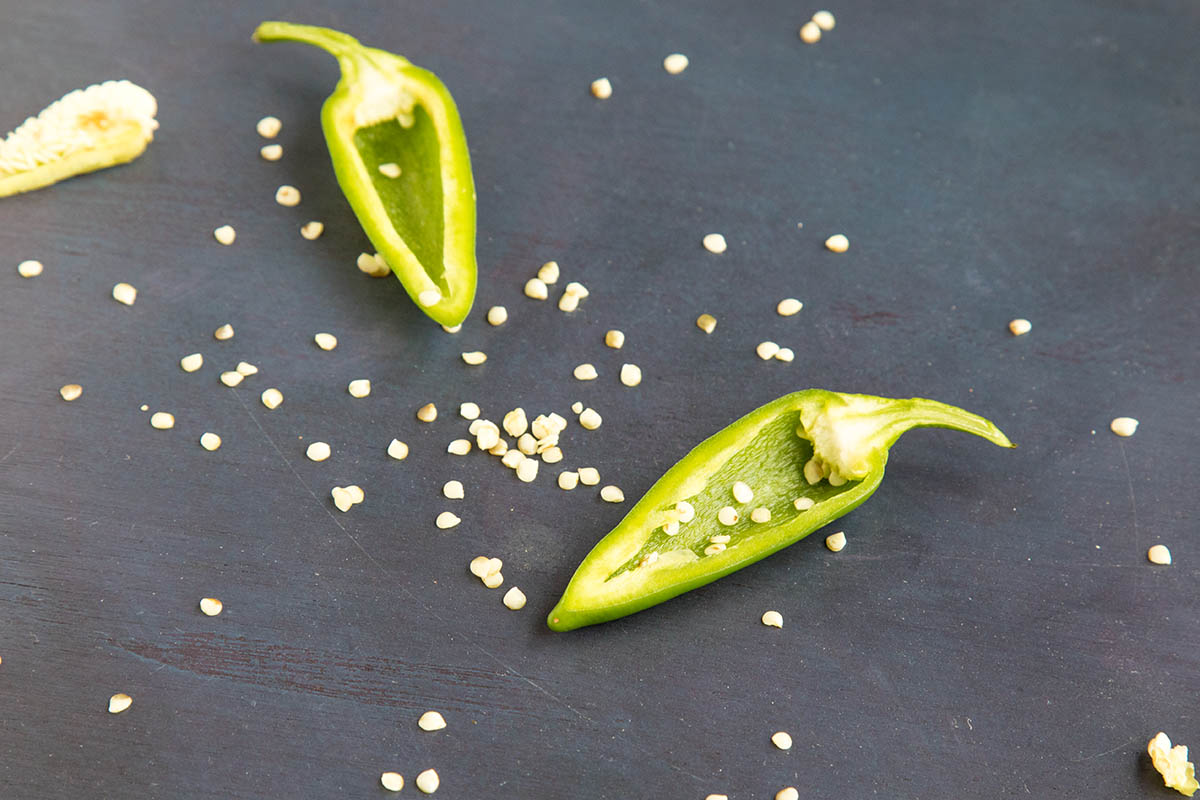
How to Save Chili Pepper Seeds for Growing
First, cut into your fresh peppers to expose the seeds. Use only fresh, healthy, mature peppers, which is very important.
Mature seeds are hard and dull white in color, where immature seeds are softer, bright, glossy white. Only mature seeds are viable for saving for future growing.
Next, clean and dry the peppers. Cut them open and remove the seeds. Some seeds are easier to remove than others. Bell peppers, for example, are quite easy, as the seeds are prominently located at the top of the pepper.
Smaller peppers, including superhots, aren’t quite as easy to remove, though still aren’t that difficult.
There are techniques, such as finely chopping or processing the peppers then mixing them with water in a bowl, allowing the seeds to sink to the bottom, but use whatever is easiest for you, whether that is using tweezers or just chopping and removing the mature seeds.
Just be sure to wear gloves when handling hot pepper pods.
Next, spread the seeds out on a flat surface indoors and away from direct sunlight in a well ventilated room. There should be no humidity.
Do not use paper plates or paper towels, as the seeds will clump and stick to them. Ceramic or coated plates work well, or even cups.
Allow to dry for 2-3 days, or up to a week. Shake or flip them each day to ensure even drying. They will be ready when a seed is brittle and breaks rather than bends when pressure is applied.
You can also use a dehydrator to dry the seeds, though temperature is very important.
Do not exceed 95 degrees F. 85 degrees F is ideal for drying pepper seeds for growing.
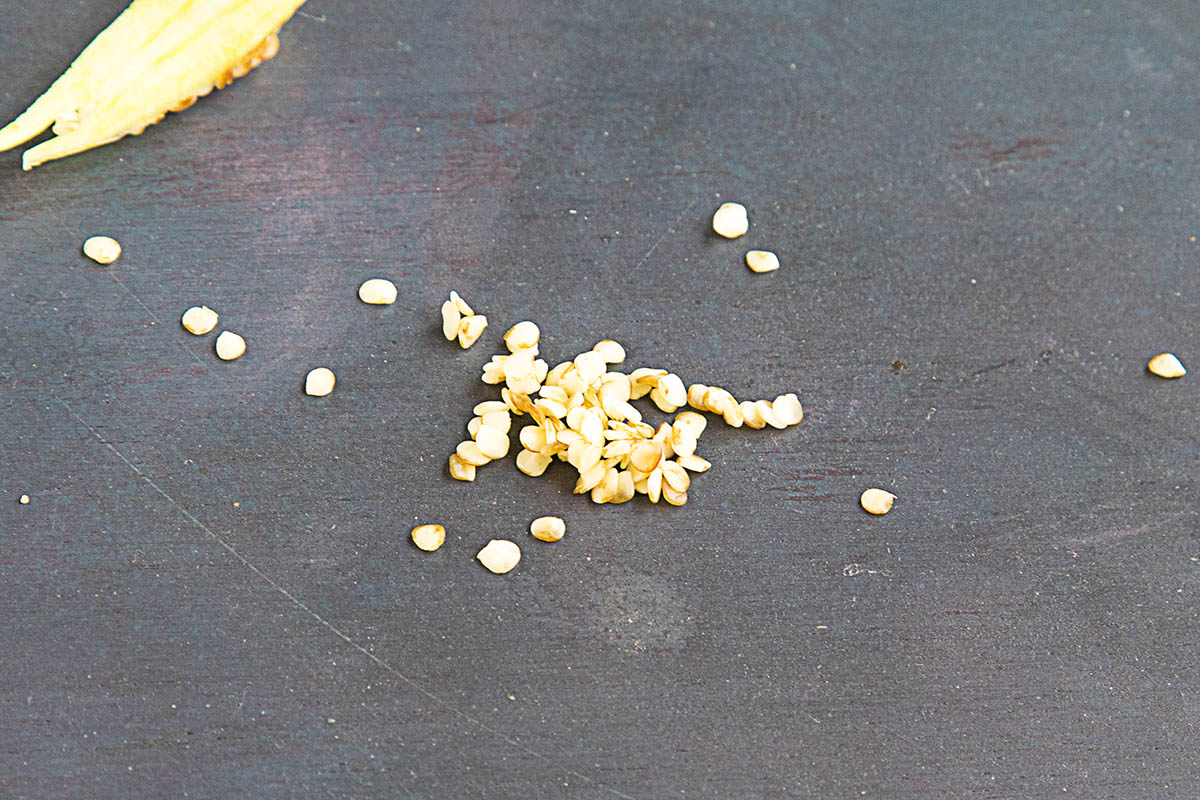
Best Pepper Seeds for Saving
You can save seeds from younger pods, but you will have more success from ripe chili pepper pods. As a best practice, let some pods grow on the plant until they become fully ripe, and even start to wrinkle a bit.
Remove the seeds and dry them per the instructions above.
Can You Save Seeds from Store Bought Peppers?
Seeds saved from store bought peppers, like bell peppers and others, aren’t likely to sprout because of the picking timing and the way they’re grown. You can try it and the seeds might sprout, but it’s unlikely.
It would be best to get viable seeds and grow them, then save those seeds from your own garden grown plants.
Storing Your Dried Chili Pepper Seeds for Growing
For longer term storage, store the seeds in airtight containers. Be sure to label them with pepper type and dates. For shorter term storage, many people use baggies or envelopes, which work as well.
Store them in a cool, dark, dry place, such as your cupboard or refrigerator. The refrigerator is the best for storage.
These seeds will be viable for approximately 2 years, though it is best to use them within a year as the genetic material can degrade and the likelihood of non-sprouting increases with age.
Learn more about growing chili peppers here - A Guide to Growing Chili Peppers.
Additional Information
- Learn More about Preserving Chili Peppers
- Learn More about Growing Chili Peppers
- Check out our Chili Pepper Recipes
Also see:
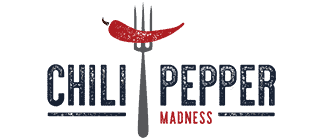

Bob Martin says
Mike, another item to factor in is if the variety you are saving is open pollenated or hybrid. Hybrid varieties may pose a problem as the parents may originate from completely different types of plants. You may end up growing a parent that won't bear any fruit whatsoever. Just make sure you are saving seeds from heirlooms or open pollenated varieties and you will be fine.
Mike H. says
Thank you for the input, Bob!
Lyne Noella says
Thank you for sharing your knowledge -- I do have favorite plants that would be wonderful to duplicate.
TIm says
Thanks again Mike. Cool article.
Mike Hultquist says
Thanks, Tim!
Doug says
Thanks for the information. Very informative and very well explained
Mike Hultquist says
Thanks, Doug. =)
Josie Magistro says
Hi Mike! My dad used to let hot hungarian banana peppers ripen to red then he used to hand-tie them by the stem together and hang until dried out. He would then use the seeds. Worked every time. Your thoughts?
Thanks!
Mike Hultquist says
Josie, yes, this is a great way to dry them, but it only works in warm, dry climates. If there is too much moisture in the air, the peppers can easily rot.
Erik says
Hi Mike, a really quick question...
If the air is humid, would drying the seeds on ceramic plate I tubs with food grade desiccant work? (Like the moisture absorption packets)
Michael Hultquist - Chili Pepper Madness says
Erik, I haven't tried that, but I think it could help considering the moisture.
Alan Thompson says
Sowed Jalapeno and Habanero seeds this year. Very early spring in Western Australia).
Probably 80% success rate with Jalapenos but the Habanero's have been very poor. Very few seeds actually germinated and most of those that did lost their leaves after a couple of days.
Same soil, same position, same watering regime.
Do Habanero's need a warmer start?
Maybe I should have planted them later?
Michael Hultquist - Chili Pepper Madness says
Alan, it could just be the seeds. I have variability each year with different plants. Pretty annoying, tbh.
John Shotsky says
I save seeds every year. I usually just cut the top out of the pepper, stem and all, with the seeds mostly attached to the seed 'ball'. I put that into a paper coffee filter until the seeds can be 'rubbed' off the core. Works well, and give a high germination. I store them in Stamp envelopes, which are designed to block out humidity. Easy to write on, and very easy to store.
Also, last year I planted a whole seed section from a store bought habanero into a red cup. I got over 50 plants. The red cup looked like a microgreens planting.
Peppers do not ripen after picking. (They might change color, but they are not ripening, just as strawberries do not ripen after picking.)
Green peppers are unlikely to have viable seeds, but ripe peppers (red, yellow, etc) should sprout just fine. To find out, just plant a few seeds and mark them while drying the rest. You will know in under a month whether they are viable or not. Because I can't usually find Manzano pepper plants locally, I save my seeds from store bought Manzanos and plant them every year.
Plant a whole store-bought habanero in a cup to see what can be done.
James says
Mike,
In my previous comment I mentioned thechileman.org. I just noticed that they are no longer hosting the seed exchange. Maybe something you might want to pick up? Ha!
Thanks!
James
Michael Hultquist - Chili Pepper Madness says
Sorry to hear, James. Oh boy, that would be a hard resource to duplicate!
James says
I used to get my seeds through a seed exchange (thechileman.org). If you have a few seeds to trade you can always swap with other hot pepper growers. Good place to get some of the more exotic peppers.
And, Mike, thanks much, I do enjoy the weekend emails.
James
Michael Hultquist - Chili Pepper Madness says
James, there are a lot of great Facebook groups dedicated to growing and seed trading. I would check those out.
Omandia says
Hi. Last year I grew Cheyenne chillis from a packet of seeds and they were definitely my favourites from the range I grew. I couldn’t find anyone selling the seeds this year but did have just 4 left in the original packet. Fortunately all 4 have grown and are fruiting now. This article was exactly what I was looking for as I am intending to save seeds from these for my own use next year. I admit hadn’t considered cross-pollination and the plants are by other types of chilli, mostly jalapeño. Never mind. It will add a touch of interest to see what they produce. Many thanks for the information.
Michael Hultquist - Chili Pepper Madness says
Glad to be helpful, Omandia!
Diane Doucette says
In general, just want to say, I love Chillipeppermadness. Great recipes and advice. So well written, easy to follow, and full of inspiration and insight. Thank you very much!!
Michael Hultquist - Chili Pepper Madness says
Thanks so much, Diane! I greatly appreciate it!
Waylon Hatch says
We own tnpepperseed and sell viable pepper seeds (and other vegetable varieties on Etsy). Check us out.
Edward Campos says
I`d like to know if the seeds from Green Chile`s can be used after the chiles have been roasted ? Thank`s for your time
Michael Hultquist - Chili Pepper Madness says
Edward, fresh seeds are best for growing. You probably wouldn't get the roasted pepper seeds to propagate.
Sara Buendia says
Well seeds saved from roasted peppers still germinate?
Michael Hultquist - Chili Pepper Madness says
Sara, very likely no because of the cooking process. The best seeds for growing are harvested from healthy, mature peppers.
Jim says
Where do you recommend I purchase seeds and/or plants
I used to buy from peppersbymail, but they have fallen on hard times.
Michael Hultquist - Chili Pepper Madness says
Jim, I have a resources section for plants and seeds on the site. Here is the link: https://www.chilipeppermadness.com/resources/. Good luck!
Leslie says
You've got me thinking. I'm always buying bell peppers at the store. I love them raw in salad. If I decide to buy one and save the seeds to grow a bellpepper plant, should I choose a red colored bellpepper in the store, not a green?
Thanks in advance!
Michael Hultquist - Chili Pepper Madness says
Hi, Leslie. Seeds saved from store bought bell peppers aren't likely to sprout because of the picking timing and the way they're grown. You can try it, but it's unlikely. It would be best to get viable seeds and grow them, then save those seeds from your own garden grown plants. I hope this helps!
Nevets says
In reply to Dan's comment about his dad's cayenne seeds producing sweet offspring, when one grows plants from commercially grown hybrids it is never guaranteed the offspring will reliably mimic or repeat the characteristics of the parent plant.
Hybrids normally only pass forward the traits of either one or the other of their parents, and rarely can they reproduce the traits of both. Selectively bred plants over several generations and open-pollinated plants are the better bets when repeatable results are desired.
Here is a link to one article expanding on my comments. Enjoy!
https://homeguides.sfgate.com/can-grow-serrano-peppers-peppers-grocery-66024.html
Michael Hultquist - Chili Pepper Madness says
Thanks, Nevets.
Dan says
Thanks for the reply and for the interesting article linked, I reckon it is a good explanation of my experience. However, a year has past and soon after my post I decided to change plans and planted rocoto chillis - open pollinated for centuries! Since they are perrenial AND pubescens I don't need to worry about cross pollination in my garden for a long while! The trees are a year old and full of green fruit now. Any suggestions for using them will be greatly appreciated as they are such a thick, juicy pepper!
Michael Hultquist - Chili Pepper Madness says
Dan, there are many recipes on the site here than can be adapted to use rocoto peppers. Take a look at my Spicy Recipes section and see what you might find. Happy to help you adapt something.
IAN FRASER says
Hi Mike,
One thing you don't mention is when the chilis germinate OK and do all right for about a week or two, but then just fail to thrive, eventually dying after about 6 weeks. I'm told it is "damping off disease". I've tried using fungicides, but still get the problem. Cold weather is not the cause. We live in Brazil! I'm so embarrassed my chilis are such a flop.
Michael Hultquist - Chili Pepper Madness says
Ian, I'm so sorry to hear! Have you treated your soil? Perhaps that is the issue.
Glen says
Hi Ian! I know this is a late reply. I live in Panama and I love to grow hot Jalepeno peppers. We have occasional damping off issues. Its normal in a tropical climate. Grow enough seedlings that you can afford to lose a few. I grow 4 or 5 in a pot and I also use more pots than I need as well. I direct seed right in the pot that the plant will live in permanently. I usually experience damping off issues. Growing more than I need helps me make sure that a few plants survive. We don't just have damping off issues. There is also those pesky cut-worms for example, as well as other issues. Just grow more plants than you need and you will have a few that will survive.
Dan says
Nice article, it reminds me of plants that my dad grew from seed, they had all the characteristics of the cayenne chilli he believed he was sowing - except the heat level, they were completely sweet. I would like to try cross pollinate plants but I would like some control, I don't want it to be completely random so if you have any tips for sucessfully propagating hybrids I would love to read them. Cheers
REPLY: I'd love to hear from other growers on this. It's pretty easy, crossing peppers. -- Mike from Chili Pepper Madness.
Bake says
if the pepper has been frozen can you still use the seeds?
REPLY: Jerry, I've heard of people growing peppers from frozen pepper seeds, though the germination rate is much lower. It's best to start from fresh seeds. However, if frozen is all you have, you can try a germination test by planting a few just to see if they sprout. -- Mike from Chili Pepper Madness.
Gary says
Your recipe indicates "your garden grown peppers". My question is can I use store bought peppers seeds ? I was told that I can't use the peppers they will not germinate. Is this true? I enjoy pablanos and would like to grow them.
Thank you
REPLY: Gary, it's hard to know if the peppers/plants have been treated with anything or if they've been grown beside other pepper plants, which might produce cross-pollination. If they've been cross-pollinated, you might get different pods. Also, it might be the case that the peppers were picked before being fully ripe, so those seeds would not be ideal. Best to use garden grown peppers for seeds. -- Mike from Chili Pepper Madness.
Palladini says
This article is right on the point. Good Article, well written and describes what to do. I put my seeds I collect on a Paper towel and put them near a Window. they dry in 2 or 3 days.